Sony really should settle on a sensible naming scheme because after toing and froing between X and Z over the last couple of years, it’s now reverting to a simple numbering system for its smartphones. Except that the Sony Xperia 10 isn’t the most advanced phone in its new lineup – it’s actually the mid-priced budget option.
In fact, the Xperia languishes such a long way behind its flagship smartphone, the Xperia 1, that I expected Sony to launch another model in between. The only other handset Sony is launching at the moment is the Xperia 10 Plus , which is essentially the same as this but with a slightly larger screen and a bigger battery, for an extra £50.
Sony Xperia 10 review: What you need to know
There is one thing that’s rather special about the Xperia 10, though. While its internal specifications are hardly worth shouting about – it’s fitted with a not-so-fancy Qualcomm Snapdragon 630 chipset and a measly 3GB of RAM – the Xperia 10 does something slightly different to its mid-range rivals.

Indeed, you might want to pick up Sony’s new handset for its unique display. Rather than sticking with the current 18:9 standard, Sony has increased the aspect ratio of its front-mounted panel to 21:9. This means the phone is quite a bit taller than the rest, with more screen space for your Instagram feed and Netflix binges.
Sony Xperia 10 review: Price and competition
The problem is that you’re expected to pay £299 for such a privilege. This puts Sony’s latest handset in the crosshairs of a veritable firing line of mid-range sharpshooters and it’s not a firefight I think the Xperia 10 is likely to survive.
Leading the posse is Xiaomi’s Pocophone F1 , which delivers astonishing value for money, with a top-end Snapdragon 845 processor running the show, complete with a superb rear camera arrangement and a screen that’s simply as good as they come.

Motorola’s Moto G7 Plus is also one tough customer, especially if you’re looking to save even more pennies. It’s fitted with a slightly better processor than the Xperia 10 and its camera actually outdoes the Pocophone F1 in a number of areas, including the ability to shoot in 4K with OIS enabled.
Sony Xperia 10 review: Design and key features
The first thing that you’ll notice about the Sony Xperia 10 is how tall and thin it is. That’s due to a couple of things. First, the aspect ratio of the display is 21:9, which is significantly skinnier and taller than most modern smartphones.
This is apparently to help you enjoy streaming movies as they were originally intended. Indeed, Sony claims 69% of Netflix movies are in the 21:9 format, making the 21:9 Xperia 10 the perfect Netflix movie-watching vehicle. That still leaves an awful lot of 16:9 content that doesn’t fit, though, and the fact that the screen isn’t particularly large or an OLED panel damages its credentials further as a screen for entertainment.
The second reason is that, instead of going for the front-filling edge-to-edge style of display that most other manufacturers are opting for these days, Sony has produced a lopsided design with a big forehead and a vanishing chin. Sure, it doesn’t have a notch but, if anything, Sony’s approach results in an odd-looking phone no matter the colour. The Xperia 10 is available in blue, silver, black or pink, by the way.

The phone also isn’t IP-rated for dust and water resistance, although that’s pretty much to be expected at this price. The Xperia 10’s side-mounted fingerprint reader is more than welcome, though, and I much prefer this thumb-unlocking method than those awkwardly placed rear-mounted and in-display sensors.
The Xperia 10’s dual-camera arrangement on the rear is aligned vertically and looks strikingly similar to a pig’s nostrils. It does look a bit boring from the back, although the phone’s rounded corners and sides ensure that it fits well in the hand, despite the rather awkward, elongated screen.
Sony Xperia 10 review: Display
Speaking of which, the phone’s display measures exactly 6in from corner to corner, and is FHD+ (2,520 x 1,080) in resolution. As I mentioned before, this is an IPS panel so you can’t expect the same sort of viewing experience as its OLED-fitted alternatives, but this is a perfectly good phone screen nonetheless.
In our display tests, it produced 89.1% of the sRGB colour gamut with image enhancements turned off, which is pretty good for a phone of this price. Switch to the “Super-Vivid” screen profile and colours generally become rather over-saturated across the palate, although not distractingly so.

The Xperia 10 also has a solid maximum brightness of 532cd/m ² , which is quite well-suited for when you’re staring at Google Maps while you’re out and about in the great outdoors. A Delta E average of 2.18 reflects the occasional colour inaccuracies, particularly in brown tones, but on the flipside, a high contrast ratio of 1539:1 lends greater vibrancy to images.
Sony Xperia 10 review: Performance and battery life
Even if you can get past the weirdly tall and thin look of the thing, you’ll still discover that the Xperia 10’s specifications aren’t up to much. Inside is a Qualcomm Snapdragon 630 processor, a chip with eight ARM Cortex A53 cores running at up to 2.2GHz, and this is backed by 3GB of RAM and 64GB of expandable storage.
With a price that’s coming in at £299, that’s a pretty underwhelming collection of core components. For the same money, you can pick up a Xiaomi Pocophone F1 with a top-level Snapdragon 845 inside, which is a chip that blows the 630 in this phone completely out of the water. In fact, both the £239 Moto G7 and £179 Moto G7 Power have more up-to-date smartphone processors than the Sony Xperia 10 – and those phones certainly aren’t the fastest budget phones around.
Either way, the Xperia 10 struggles to keep up with all of them, achieving a multi-core CPU speed of 4,090 in the Geekbench 4 test. Of course, that’s by no means an atrocious score – the phone itself is still perfectly useable – but if you’re able to achieve better speeds for less, it’s time to admit Sony has done something quite wrong here.
On to gaming and the story is pretty much the same. In the GFXBench Manhattan 3 on-screen benchmark, the Xperia 10 maintained an average of only 11fps, whereas the Moto G7 Power ran the same test at 20fps. Again, the Pocophone F1 is the clear winner, achieving a practically perfect frame rate of 59fps.
Things don’t even get much better when it comes to the Xperia 10’s overall battery life. In our in-house video rundown test, the Xperia 10 lasted for a disappointing 9hrs before the battery percentage plummeted to zero. That’s certainly not a great score, especially when the beefed-up Pocophone F1 can reach 15hrs 29mins under the exact same conditions.
Sony Xperia 1 review: Software
Unsurprisingly, the Xperia 10 is running Google’s latest version of its mobile operating system, Android 9.0 Pie. Sony’s own software overlay is placed over the top once more but, as with previous versions, this actually functions rather well. It isn’t anywhere near as intrusive as some of the other Android tweaks on the market.
In fact, the only unusual thing about the Sony is that it has an area in the middle of the right edge of the screen that, when swiped, brings up a quick app launcher. I’m not convinced anyone’s going to buy a phone on the strength of that, though.
Sony Xperia 10 review: Camera
How about the camera? Well, that’s not particularly exciting but at least it’s a bit more standard-issue than the Snapdragon 630 chipset. You’re getting a 13-megapixel shooter with a rather small 1.3in sensor and a 5-megapixel camera that carries out depth-sensing duties so you can create convincing blurred-background images without needing a proper camera. Again, that’s no different to the Motorola Moto G7, which does the same sort of thing for considerably less money.
Photo quality is rather good for the money, but, again, the same can be said of the Moto G7. The Xperia 10 was capable of capturing some truly exceptional images of the rainy London skyline with oodles of detail, well-exposed HDR and neutral colour reproduction without overly excessive vibrancy.
Outdoor picture quality might be roughly equal between the two handsets, but as the light dims, the Moto G7 comes out on top. Placing both shots next to each other, it’s clear that the Moto G7 captures images with greater detail, with more notable definition to the teddy bear fur. Visual noise is also less of an issue.
Lastly, the Xperia 10 is able to shoot video at a maximum recording resolution of 4K in either 21:9 or regular 16:9 format. Both of these are locked at a frame rate of 30fps, although dropping the quality down to Full HD allows for 60fps recording. Other fancy video features such as object tracking and Sony’s SteadyShot image stabilisation are also unavailable in 4K.
Sony Xperia 10 review: Verdict
Other than the unusual screen and decent photographic capabilities, there’s very little here to shout about. Yes, the phone feels nice in the hand – largely due to the use of Gorilla Glass 5 on the front – but it looks odd and the slightly underwhelming specifications just make things worse.
With the price coming in at the mid-range mark, the Xperia 10 is a bit of a mixed bag. Of course, it has its merits but based on the poor performance and disappointing battery life, I’m certain that this is not going to be one of the must-buy handsets of 2019.
|
Sony Xperia 10 specifications |
|
Processor |
Octa-core Qualcomm Snapdragon 630 (8x2.2GHz) |
|
RAM |
3GB |
|
Screen size |
6in |
|
Screen resolution |
2,520x1,080 |
|
Pixel density |
457ppi |
|
Screen type |
IPS |
|
Front camera |
8-megapixel, f/2.0 |
|
Rear camera |
13-megapixel f/2.0, 5-megapixel f/2.4 |
|
Flash |
LED |
|
Dust and water resistance |
N/A |
|
3.5mm headphone jack |
Yes |
|
Wireless charging |
No |
|
USB connection type |
USB Type-C |
|
Storage options |
64GB |
|
Memory card slot (supplied) |
microSD (512GB) |
|
Wi-Fi |
802.11ac |
|
Bluetooth |
5 |
|
NFC |
Yes |
|
Cellular data |
4G |
|
Dual SIM |
No |
|
Dimensions (WDH) |
156 x 68 x 8.4 mm |
|
Weight |
162g |
|
Operating system |
Android 9.0 |
|
Battery size |
2,870mAh |











